Kannan Achan
Spatial Reasoning in Foundation Models: Benchmarking Object-Centric Spatial Understanding
Sep 26, 2025Abstract:Spatial understanding is a critical capability for vision foundation models. While recent advances in large vision models or vision-language models (VLMs) have expanded recognition capabilities, most benchmarks emphasize localization accuracy rather than whether models capture how objects are arranged and related within a scene. This gap is consequential; effective scene understanding requires not only identifying objects, but reasoning about their relative positions, groupings, and depth. In this paper, we present a systematic benchmark for object-centric spatial reasoning in foundation models. Using a controlled synthetic dataset, we evaluate state-of-the-art vision models (e.g., GroundingDINO, Florence-2, OWLv2) and large VLMs (e.g., InternVL, LLaVA, GPT-4o) across three tasks: spatial localization, spatial reasoning, and downstream retrieval tasks. We find a stable trade-off: detectors such as GroundingDINO and OWLv2 deliver precise boxes with limited relational reasoning, while VLMs like SmolVLM and GPT-4o provide coarse layout cues and fluent captions but struggle with fine-grained spatial context. Our study highlights the gap between localization and true spatial understanding, and pointing toward the need for spatially-aware foundation models in the community.
VL-CLIP: Enhancing Multimodal Recommendations via Visual Grounding and LLM-Augmented CLIP Embeddings
Jul 22, 2025Abstract:Multimodal learning plays a critical role in e-commerce recommendation platforms today, enabling accurate recommendations and product understanding. However, existing vision-language models, such as CLIP, face key challenges in e-commerce recommendation systems: 1) Weak object-level alignment, where global image embeddings fail to capture fine-grained product attributes, leading to suboptimal retrieval performance; 2) Ambiguous textual representations, where product descriptions often lack contextual clarity, affecting cross-modal matching; and 3) Domain mismatch, as generic vision-language models may not generalize well to e-commerce-specific data. To address these limitations, we propose a framework, VL-CLIP, that enhances CLIP embeddings by integrating Visual Grounding for fine-grained visual understanding and an LLM-based agent for generating enriched text embeddings. Visual Grounding refines image representations by localizing key products, while the LLM agent enhances textual features by disambiguating product descriptions. Our approach significantly improves retrieval accuracy, multimodal retrieval effectiveness, and recommendation quality across tens of millions of items on one of the largest e-commerce platforms in the U.S., increasing CTR by 18.6%, ATC by 15.5%, and GMV by 4.0%. Additional experimental results show that our framework outperforms vision-language models, including CLIP, FashionCLIP, and GCL, in both precision and semantic alignment, demonstrating the potential of combining object-aware visual grounding and LLM-enhanced text representation for robust multimodal recommendations.
LLM-driven Constrained Copy Generation through Iterative Refinement
Apr 14, 2025Abstract:Crafting a marketing message (copy), or copywriting is a challenging generation task, as the copy must adhere to various constraints. Copy creation is inherently iterative for humans, starting with an initial draft followed by successive refinements. However, manual copy creation is time-consuming and expensive, resulting in only a few copies for each use case. This limitation restricts our ability to personalize content to customers. Contrary to the manual approach, LLMs can generate copies quickly, but the generated content does not consistently meet all the constraints on the first attempt (similar to humans). While recent studies have shown promise in improving constrained generation through iterative refinement, they have primarily addressed tasks with only a few simple constraints. Consequently, the effectiveness of iterative refinement for tasks such as copy generation, which involves many intricate constraints, remains unclear. To address this gap, we propose an LLM-based end-to-end framework for scalable copy generation using iterative refinement. To the best of our knowledge, this is the first study to address multiple challenging constraints simultaneously in copy generation. Examples of these constraints include length, topics, keywords, preferred lexical ordering, and tone of voice. We demonstrate the performance of our framework by creating copies for e-commerce banners for three different use cases of varying complexity. Our results show that iterative refinement increases the copy success rate by $16.25-35.91$% across use cases. Furthermore, the copies generated using our approach outperformed manually created content in multiple pilot studies using a multi-armed bandit framework. The winning copy improved the click-through rate by $38.5-45.21$%.
Improving Sequential Recommender Systems with Online and In-store User Behavior
Dec 03, 2024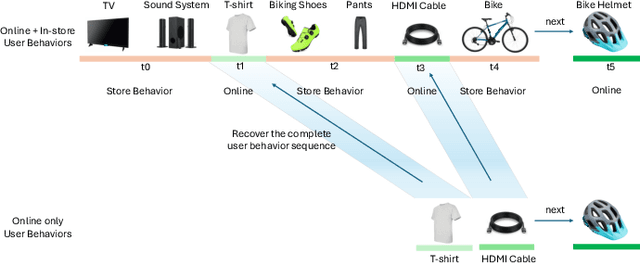
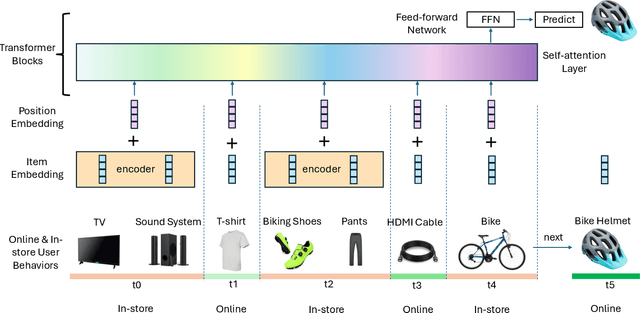
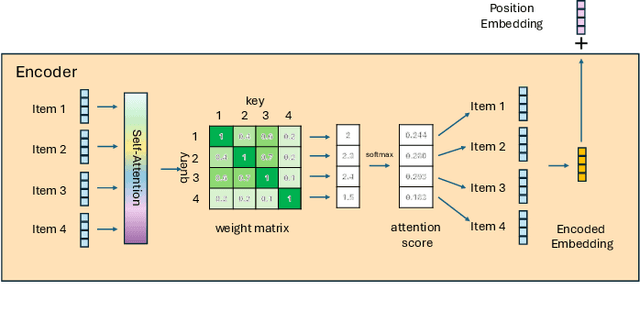

Abstract:Online e-commerce platforms have been extending in-store shopping, which allows users to keep the canonical online browsing and checkout experience while exploring in-store shopping. However, the growing transition between online and in-store becomes a challenge to sequential recommender systems for future online interaction prediction due to the lack of holistic modeling of hybrid user behaviors (online and in-store). The challenges are twofold. First, combining online and in-store user behavior data into a single data schema and supporting multiple stages in the model life cycle (pre-training, training, inference, etc.) organically needs a new data pipeline design. Second, online recommender systems, which solely rely on online user behavior sequences, must be redesigned to support online and in-store user data as input under the sequential modeling setting. To overcome the first challenge, we propose a hybrid, omnichannel data pipeline to compile online and in-store user behavior data by caching information from diverse data sources. Later, we introduce a model-agnostic encoder module to the sequential recommender system to interpret the user in-store transaction and augment the modeling capacity for better online interaction prediction given the hybrid user behavior.
Triple Modality Fusion: Aligning Visual, Textual, and Graph Data with Large Language Models for Multi-Behavior Recommendations
Oct 16, 2024
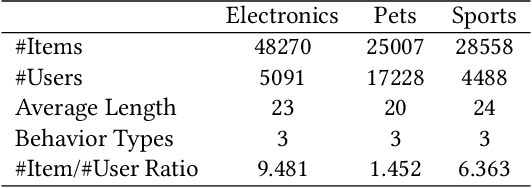
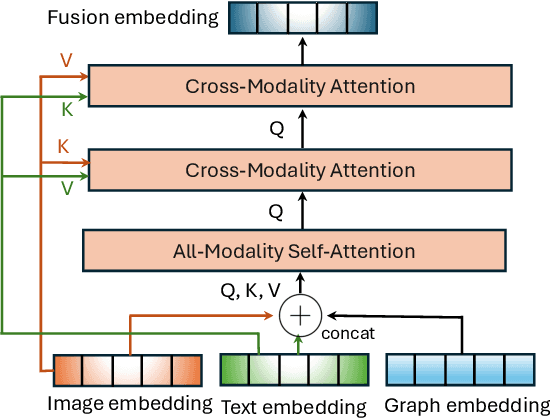

Abstract:Integrating diverse data modalities is crucial for enhancing the performance of personalized recommendation systems. Traditional models, which often rely on singular data sources, lack the depth needed to accurately capture the multifaceted nature of item features and user behaviors. This paper introduces a novel framework for multi-behavior recommendations, leveraging the fusion of triple-modality, which is visual, textual, and graph data through alignment with large language models (LLMs). By incorporating visual information, we capture contextual and aesthetic item characteristics; textual data provides insights into user interests and item features in detail; and graph data elucidates relationships within the item-behavior heterogeneous graphs. Our proposed model called Triple Modality Fusion (TMF) utilizes the power of LLMs to align and integrate these three modalities, achieving a comprehensive representation of user behaviors. The LLM models the user's interactions including behaviors and item features in natural languages. Initially, the LLM is warmed up using only natural language-based prompts. We then devise the modality fusion module based on cross-attention and self-attention mechanisms to integrate different modalities from other models into the same embedding space and incorporate them into an LLM. Extensive experiments demonstrate the effectiveness of our approach in improving recommendation accuracy. Further ablation studies validate the effectiveness of our model design and benefits of the TMF.
Decoding Style: Efficient Fine-Tuning of LLMs for Image-Guided Outfit Recommendation with Preference
Sep 18, 2024
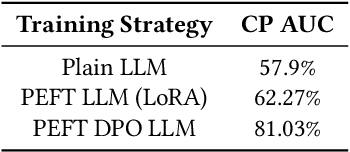


Abstract:Personalized outfit recommendation remains a complex challenge, demanding both fashion compatibility understanding and trend awareness. This paper presents a novel framework that harnesses the expressive power of large language models (LLMs) for this task, mitigating their "black box" and static nature through fine-tuning and direct feedback integration. We bridge the item visual-textual gap in items descriptions by employing image captioning with a Multimodal Large Language Model (MLLM). This enables the LLM to extract style and color characteristics from human-curated fashion images, forming the basis for personalized recommendations. The LLM is efficiently fine-tuned on the open-source Polyvore dataset of curated fashion images, optimizing its ability to recommend stylish outfits. A direct preference mechanism using negative examples is employed to enhance the LLM's decision-making process. This creates a self-enhancing AI feedback loop that continuously refines recommendations in line with seasonal fashion trends. Our framework is evaluated on the Polyvore dataset, demonstrating its effectiveness in two key tasks: fill-in-the-blank, and complementary item retrieval. These evaluations underline the framework's ability to generate stylish, trend-aligned outfit suggestions, continuously improving through direct feedback. The evaluation results demonstrated that our proposed framework significantly outperforms the base LLM, creating more cohesive outfits. The improved performance in these tasks underscores the proposed framework's potential to enhance the shopping experience with accurate suggestions, proving its effectiveness over the vanilla LLM based outfit generation.
Leveraging User-Generated Reviews for Recommender Systems with Dynamic Headers
Sep 11, 2024Abstract:E-commerce platforms have a vast catalog of items to cater to their customers' shopping interests. Most of these platforms assist their customers in the shopping process by offering optimized recommendation carousels, designed to help customers quickly locate their desired items. Many models have been proposed in academic literature to generate and enhance the ranking and recall set of items in these carousels. Conventionally, the accompanying carousel title text (header) of these carousels remains static. In most instances, a generic text such as "Items similar to your current viewing" is utilized. Fixed variations such as the inclusion of specific attributes "Other items from a similar seller" or "Items from a similar brand" in addition to "frequently bought together" or "considered together" are observed as well. This work proposes a novel approach to customize the header generation process of these carousels. Our work leverages user-generated reviews that lay focus on specific attributes (aspects) of an item that were favorably perceived by users during their interaction with the given item. We extract these aspects from reviews and train a graph neural network-based model under the framework of a conditional ranking task. We refer to our innovative methodology as Dynamic Text Snippets (DTS) which generates multiple header texts for an anchor item and its recall set. Our approach demonstrates the potential of utilizing user-generated reviews and presents a unique paradigm for exploring increasingly context-aware recommendation systems.
Prompt Optimizer of Text-to-Image Diffusion Models for Abstract Concept Understanding
Apr 17, 2024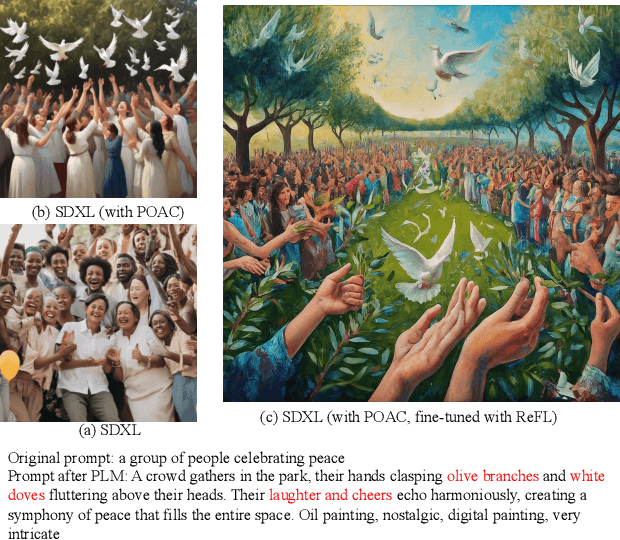
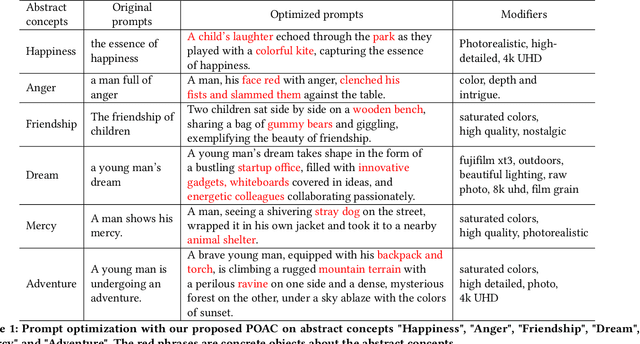
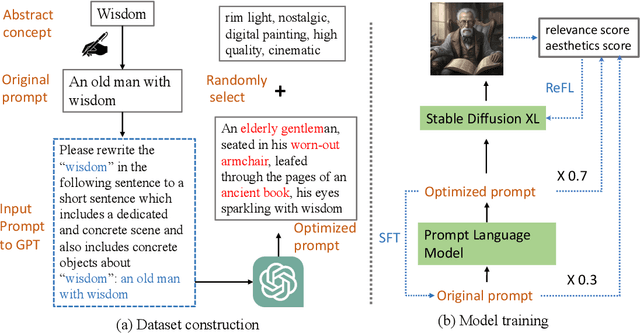

Abstract:The rapid evolution of text-to-image diffusion models has opened the door of generative AI, enabling the translation of textual descriptions into visually compelling images with remarkable quality. However, a persistent challenge within this domain is the optimization of prompts to effectively convey abstract concepts into concrete objects. For example, text encoders can hardly express "peace", while can easily illustrate olive branches and white doves. This paper introduces a novel approach named Prompt Optimizer for Abstract Concepts (POAC) specifically designed to enhance the performance of text-to-image diffusion models in interpreting and generating images from abstract concepts. We propose a Prompt Language Model (PLM), which is initialized from a pre-trained language model, and then fine-tuned with a curated dataset of abstract concept prompts. The dataset is created with GPT-4 to extend the abstract concept to a scene and concrete objects. Our framework employs a Reinforcement Learning (RL)-based optimization strategy, focusing on the alignment between the generated images by a stable diffusion model and optimized prompts. Through extensive experiments, we demonstrate that our proposed POAC significantly improves the accuracy and aesthetic quality of generated images, particularly in the description of abstract concepts and alignment with optimized prompts. We also present a comprehensive analysis of our model's performance across diffusion models under different settings, showcasing its versatility and effectiveness in enhancing abstract concept representation.
LLM-Ensemble: Optimal Large Language Model Ensemble Method for E-commerce Product Attribute Value Extraction
Feb 29, 2024


Abstract:Product attribute value extraction is a pivotal component in Natural Language Processing (NLP) and the contemporary e-commerce industry. The provision of precise product attribute values is fundamental in ensuring high-quality recommendations and enhancing customer satisfaction. The recently emerging Large Language Models (LLMs) have demonstrated state-of-the-art performance in numerous attribute extraction tasks, without the need for domain-specific training data. Nevertheless, varying strengths and weaknesses are exhibited by different LLMs due to the diversity in data, architectures, and hyperparameters. This variation makes them complementary to each other, with no single LLM dominating all others. Considering the diverse strengths and weaknesses of LLMs, it becomes necessary to develop an ensemble method that leverages their complementary potentials. In this paper, we propose a novel algorithm called LLM-ensemble to ensemble different LLMs' outputs for attribute value extraction. We iteratively learn the weights for different LLMs to aggregate the labels with weights to predict the final attribute value. Not only can our proposed method be proven theoretically optimal, but it also ensures efficient computation, fast convergence, and safe deployment. We have also conducted extensive experiments with various state-of-the-art LLMs, including Llama2-13B, Llama2-70B, PaLM-2, GPT-3.5, and GPT-4, on Walmart's internal data. Our offline metrics demonstrate that the LLM-ensemble method outperforms all the state-of-the-art single LLMs on Walmart's internal dataset. This method has been launched in several production models, leading to improved Gross Merchandise Volume (GMV), Click-Through Rate (CTR), Conversion Rate (CVR), and Add-to-Cart Rate (ATC).
Chaining text-to-image and large language model: A novel approach for generating personalized e-commerce banners
Feb 28, 2024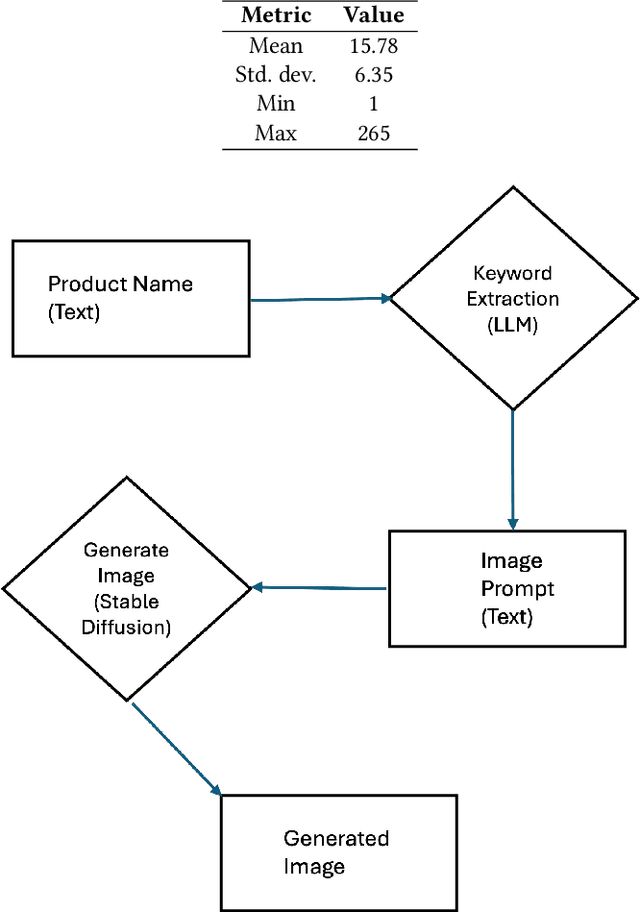


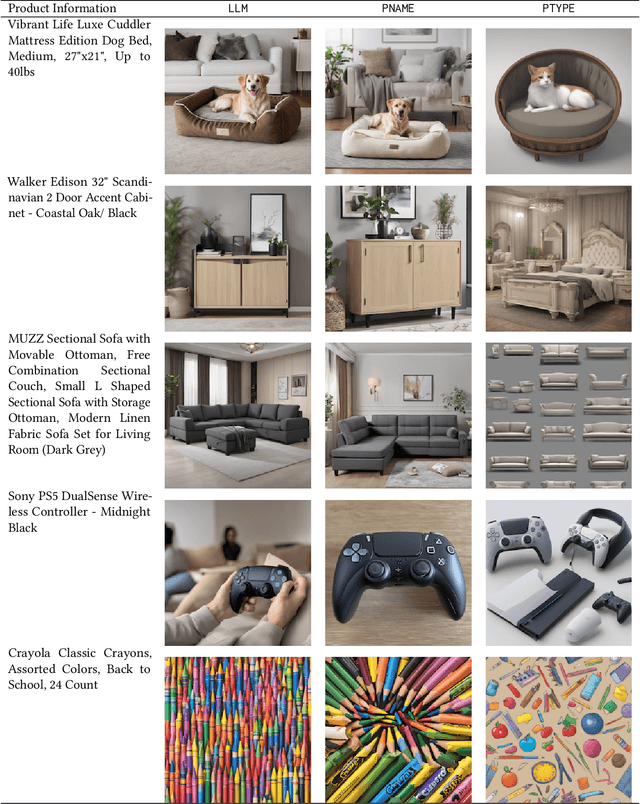
Abstract:Text-to-image models such as stable diffusion have opened a plethora of opportunities for generating art. Recent literature has surveyed the use of text-to-image models for enhancing the work of many creative artists. Many e-commerce platforms employ a manual process to generate the banners, which is time-consuming and has limitations of scalability. In this work, we demonstrate the use of text-to-image models for generating personalized web banners with dynamic content for online shoppers based on their interactions. The novelty in this approach lies in converting users' interaction data to meaningful prompts without human intervention. To this end, we utilize a large language model (LLM) to systematically extract a tuple of attributes from item meta-information. The attributes are then passed to a text-to-image model via prompt engineering to generate images for the banner. Our results show that the proposed approach can create high-quality personalized banners for users.
 Add to Chrome
Add to Chrome Add to Firefox
Add to Firefox Add to Edge
Add to Edge